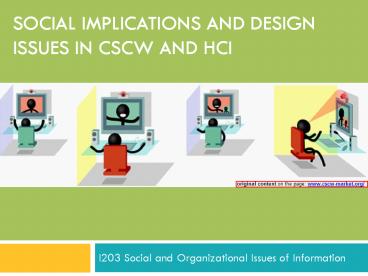Social%20implications%20and%20design%20Issues%20in%20CSCW%20and%20HCI - PowerPoint PPT Presentation
Title:
Social%20implications%20and%20design%20Issues%20in%20CSCW%20and%20HCI
Description:
Title: Lecture 5 Author: Coye Cheshire Last modified by: Judd Created Date: 12/16/2005 8:52:51 PM Document presentation format: On-screen Show (4:3) – PowerPoint PPT presentation
Number of Views:122
Avg rating:3.0/5.0
Title: Social%20implications%20and%20design%20Issues%20in%20CSCW%20and%20HCI
1
Social implications and design Issues in CSCW and
HCI
- I203 Social and Organizational Issues of
Information
2
Administrative Fun
- Assignment 3
- Reading Response Papers
- Final Paper
3
Assignment 3
- Shorter than Assn 1, tied more directly to final
paper. - The purpose of the assignment is to work from our
own class reading examples to identify and frame
problems and arguments.
4
A Few Social Challenges for Design in
Human-Computer Interaction
Huggable HAL 9000 from Laura MacCary
5
(No Transcript)
6
(No Transcript)
7
Part of this is a sub-area in HCI Do we treat
computers as social entities?
- Nass and colleagues research Politeness,
Flattery, Gender stereotyping in computers and
interfaces. - Kiesler and Sproull Cooperation and Trust with
computers and interfaces.
8
Computers as Social (Nass)
- People appear to obey politeness norms with
computers - People appear to prefer responses from computers
that match their own personality type - Includes quality of interaction and competence
- People like to be flattered by computer responses
- People appear to apply gender stereotypes to
computers - People appear to orient their reactions to the
computer, not the programmer(s).
9
Computers as not social (Kiesler and Sproull)
- We love dogs and people, but people seem to
cooperate more with people-like computer partners
than dog-like partners. - Our reactions may be a learned response
- We have to look at the situation and our
expectations to understand our seemingly social
responses. - If we want such research to inform design, then
we have to actually specify what aspect of the
computer we are examining (all software? Specific
interface characteristics?)
10
Challenges for design in CSCW
- What is CSCW and why is it important?
- Study of the various ways that individuals work
in groups and the technologies (hardware and
software).
11
Select Findings in CSCW (Ackerman)
- Exceptions tend to be the norm in work processes
- People prefer to know who else is present in a
shared space, and how they are performing - Visibility of communication and information
exchange can enable learning, but also works
against efficiency under some circumstances. - Norms emerge for CSCW systems, and these norms
tend to be constantly re-negotiated. - Critical Mass problems
- Importance of Incentives (tied to many other
issues above)
12
The Social-Technical Gap
13
Much ado about nothing?
- The gap is just a mistake caused by early
miscommunications, or just habit of software
designers/researchers. - We just have not found the proper solution with
existing technologies eventually we will so the
gap is a moot point. - Instead of complaining about it, we should just
change our behavior (i.e. adapt) to work with the
technology the way it is supposed to be used.
14
CSCW as a Science of the Artificial
- CSCW is at once an engineering discipline
attempting to construct suitable systems for
groups, organizations, and other collectivities,
and ad the same time, CSCW is a social science
attempting to understand the basis for that
construction in the social world - Ackerman (2000 13)
15
No Silver Bullet?

